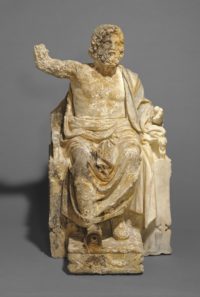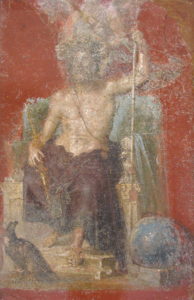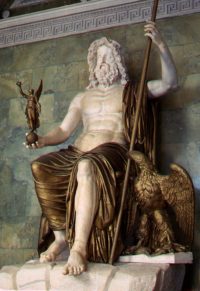 A statue of Zeus that was part of the ill-gotten antiquities in the collection of the J. Paul Getty Museum has returned to its place of origin, the Archaeological Park of Campi Flegrei at the Castle of Baiae on the Gulf of Naples. The museum acquired the statue in 1992 under the tenure of Marion True who would later be tried for her long history of buying looting antiquities from shady dealers. The Getty bought it from Barbara and Lawrence Fleischman, wealthy private collectors who had a $60 million collection of antiquities. They got this statue and many, many others like it from infamous loot dealer, perjurer and cheater Robin Symes.
A statue of Zeus that was part of the ill-gotten antiquities in the collection of the J. Paul Getty Museum has returned to its place of origin, the Archaeological Park of Campi Flegrei at the Castle of Baiae on the Gulf of Naples. The museum acquired the statue in 1992 under the tenure of Marion True who would later be tried for her long history of buying looting antiquities from shady dealers. The Getty bought it from Barbara and Lawrence Fleischman, wealthy private collectors who had a $60 million collection of antiquities. They got this statue and many, many others like it from infamous loot dealer, perjurer and cheater Robin Symes.
The lack of export paperwork or ownership history was no deterrent to these acquisitions, and the Getty only agreed to return the statue in 2017, five years after a missing piece of it was found by local archaeologists in the ancient resort town of Baiae, modern-day Bacoli. The statue was repatriated in June 2017 and put on display at the National Archeological Museum in Naples. In late October it was loaned to Archaeological Park of Campi Flegrei so it could take part in a new exhibition of artworks that once adorned the villas of the rich and powerful at Baiae and environs.
 Zeus Enthroned is a 29-inch-high marble statue dating to the 1st century B.C. and is likely of Greek manufacture. It was inspired by the colossal gold and ivory statue of the god at the temple of Zeus at Olympia made by sculptor Pheidias in 430 B.C. It was one of the Seven Wonders of the ancient world. First century orator and philosopher Dio Chrysostom wrote about it in glowing terms in his Olympic Discourse:
Zeus Enthroned is a 29-inch-high marble statue dating to the 1st century B.C. and is likely of Greek manufacture. It was inspired by the colossal gold and ivory statue of the god at the temple of Zeus at Olympia made by sculptor Pheidias in 430 B.C. It was one of the Seven Wonders of the ancient world. First century orator and philosopher Dio Chrysostom wrote about it in glowing terms in his Olympic Discourse:
For verily even the irrational brute creation would be so struck with awe if they could catch merely a glimpse of yonder statue, not only the bulls which are being continually led to the altar, so that they would willingly submit themselves to the priests who perform the rites of sacrifice, if so they would be giving some pleasure to the god, but eagles too, and horses and lions, so that they would subdue their untamed and savage spirits and preserve perfect quiet, delighted by the vision; and of men, whoever is sore distressed in soul, having in the course of his life drained the cup of many misfortunes and griefs, nor ever winning sweet sleep — even this man, methinks, if he stood before this image, would forget all the terrors and hardships that fall to our human lot.
The temple of Zeus was abandoned in the 4th century when emperor Theodosius I banned the Olympic games and all the religious rituals attendant to them in 393 A.D. It’s known when the statue was destroyed.
 By then, Pheidias’ masterpiece had been considered the pinnacle of Classical Greek sculpture for 700 years and it was widely copied in the Greco-Roman world. A fresco of Zeus enthroned holding a statue of Nike (Victory), a scepter with an eagle by his side a fresco was found in the Casa dei Dioscuri in Pompeii and is now in the National Archaeological Museum of Naples. A statue 11 feet high created in the 1st century A.D. and discovered at the villa of Emperor Domitian (now at the Hermitage Museum) meticulously copied the original, using marble, gilded wood and stucco to capture the beauty of the chryselephantine technique.
By then, Pheidias’ masterpiece had been considered the pinnacle of Classical Greek sculpture for 700 years and it was widely copied in the Greco-Roman world. A fresco of Zeus enthroned holding a statue of Nike (Victory), a scepter with an eagle by his side a fresco was found in the Casa dei Dioscuri in Pompeii and is now in the National Archaeological Museum of Naples. A statue 11 feet high created in the 1st century A.D. and discovered at the villa of Emperor Domitian (now at the Hermitage Museum) meticulously copied the original, using marble, gilded wood and stucco to capture the beauty of the chryselephantine technique.
The Zeus Enthroned sits on a throne, a high-backed one, and rests his feet on a stool. His right arm is raised high, his left by his side. His raised hand likely held a high scepter and his left a thunderbolt. If it precisely matched the Pheidias statue, however, the left hand would have held a statuette of the goddess of Victory. The attributes are long missing as is the right hand so it’s hard to know what he carried.
Evidence of marine life is rife on the right side of the statue and its condition is far more deteriorated there than on the left side. The statue was likely resting on its left side in the sand of the seabed. The sand protected it from the elements. Before then, it was probably part of a home shrine in one of the elegant country villas that were so popular among the wealthy of the late Roman Republic.
On the Pompeii fresco -right next to his throne- there is what looks very similar to a globe, i.e an earth sphere model.
——————-
The ‘Fasti’ (“Six Books of the Calendar”) is a six-book Latin poem written Ovid, published in 8 AD. In Bk. Six, it reads:
…Arte Syracosia suspensus in aere clauso stat globus, immensi parva figura poli, et quantum a summis, tantum secessit ab imis terra; quod ut fiat, forma rotunda facit, par facies templi: nullus procurrit in illo angulus; a pluvio vindicat imbre tholus…
…There’s a globe suspended, enclosed by Syracusan art, that is a small replica of the vast heavens, and the Earth is equidistant from top and bottom. Which is achieved by its spherical shape. the form of this temple’s the same: there’s no angle projecting from it: a rotunda saves it from the rain. …
Come on, Livius, let us know how you really feel about the people mentioned. Don’t hold back. 😉
I just wanted to take a moment to say how much I appreciate your blog posts. They’re always well-written, informative, and keep me coming back for more. Keep up the great work!